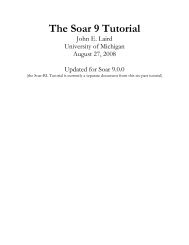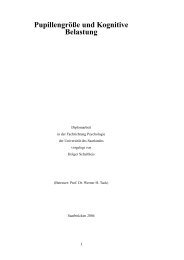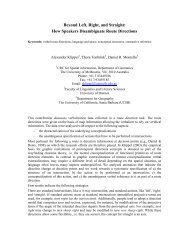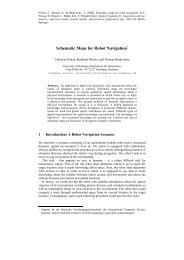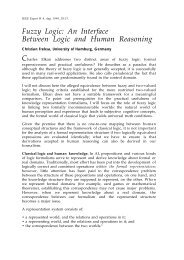SparQ: A Toolbox for Qualitative Spatial Representation and ...
SparQ: A Toolbox for Qualitative Spatial Representation and ...
SparQ: A Toolbox for Qualitative Spatial Representation and ...
Create successful ePaper yourself
Turn your PDF publications into a flip-book with our unique Google optimized e-Paper software.
( def-calculus " Relative distance calculus ( reldistcalculus )"<br />
: arity : ternary<br />
: base-relations ( same closer farther )<br />
: identity-relation same<br />
5 : inverse-operation (( same same )<br />
( closer closer )<br />
( farther farther ))<br />
: composition-operation (( same same ( same closer farther ))<br />
( same closer ( same closer farther ))<br />
10 ( same farther ( same closer farther ))<br />
( closer same ( same closer farther ))<br />
( closer closer ( same closer farther ))<br />
( closer farther ( same closer farther ))<br />
[...]<br />
Listing 1.1. Specification of a simple ternary calculus (excerpt).<br />
In addition to the calculus specification, it is necessary to provide the implementation<br />
of a qualifier function which <strong>for</strong> an n-ary calculus takes n geometric<br />
objects of the corresponding base type as input <strong>and</strong> returns the relation holding<br />
between these objects. The qualifier function encapsulates the methods <strong>for</strong> computing<br />
the qualitative relations from quantitative geometric descriptions. If it is<br />
not provided, the qualify module will not work <strong>for</strong> this calculus.<br />
For some calculi, it is not possible to provide operations in <strong>for</strong>m of simple<br />
tables as in the example. For instance, OPRAm has an additional parameter<br />
that specifies the granularity <strong>and</strong> influences the number of base relations. Thus,<br />
the operations can only be provided in procedural <strong>for</strong>m, meaning the result of<br />
the operations are computed from the input relations when they are required.<br />
For these cases, <strong>SparQ</strong> allows to provide the operations as implemented functions<br />
<strong>and</strong> uses a caching mechanism to store often required results.<br />
5 Integrating <strong>SparQ</strong> into own applications<br />
<strong>SparQ</strong> can also run in server mode which makes it easy to integrate it into own<br />
applications. We have chosen a client/server approach as it allows <strong>for</strong> straight<strong>for</strong>ward<br />
integration independent of the programming language used <strong>for</strong> implementing<br />
the application.<br />
When run in server mode, <strong>SparQ</strong> takes TCP/IP connections <strong>and</strong> interacts<br />
with the client via simple plain-text line-based communication. This means the<br />
client sends comm<strong>and</strong>s which consist of everything following the ‘./sparq’ in the<br />
examples in this text, <strong>and</strong> can then read the results from the TCP/IP stream.<br />
An example is given in Listing 1.2: A Python script opens a connection to<br />
the <strong>SparQ</strong>-server <strong>and</strong> per<strong>for</strong>ms some simple computations (qualification, adding<br />
another relation, checking <strong>for</strong> path-consistency). It produces the following output:<br />
> ( (A rrll B) (A rrll C) )<br />
> ( (A rrll B) (A rrll C) (B eses C) )<br />
> Not consistent.<br />
> ( (B (eses) C) (A () C) (A (rrll) B) )



